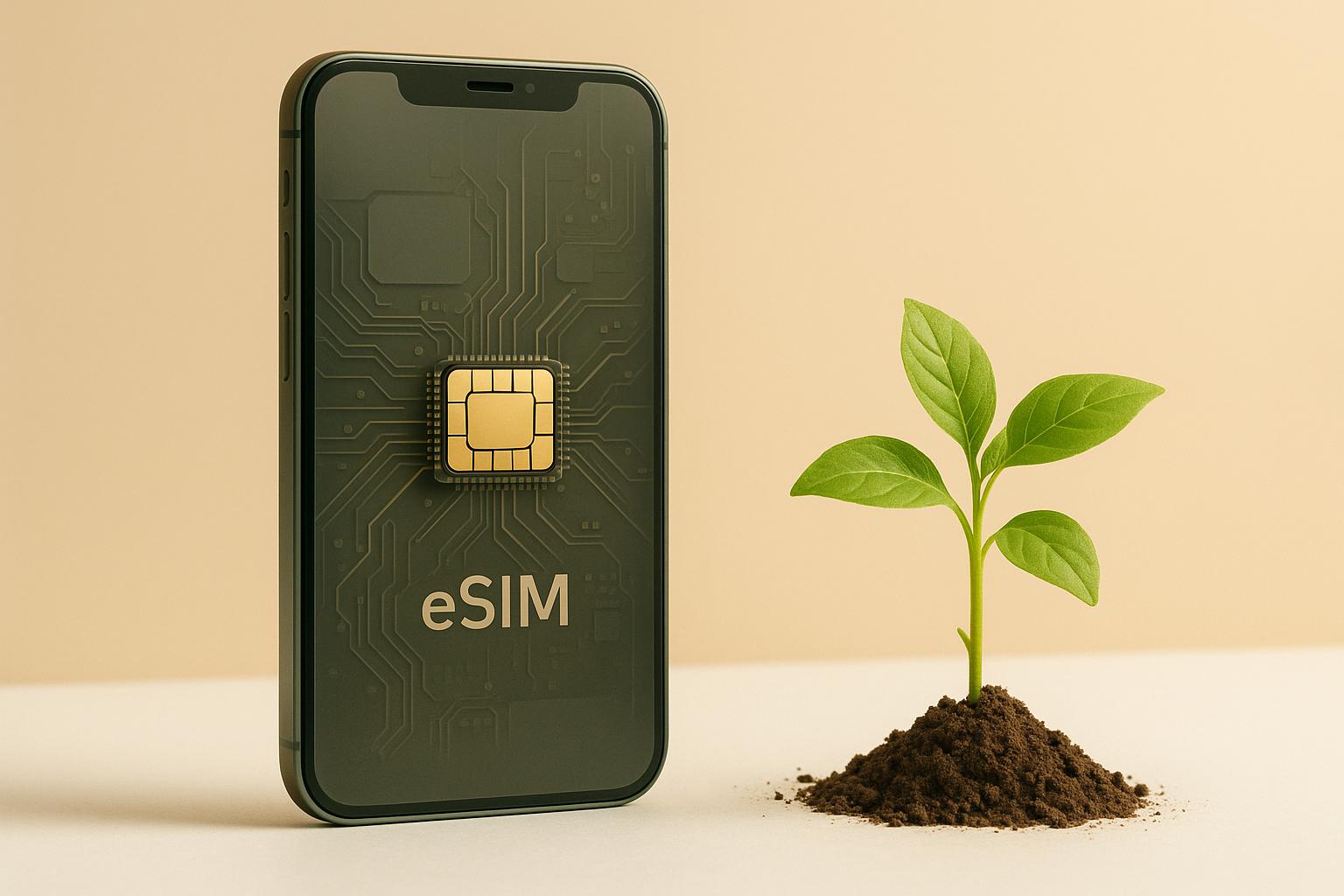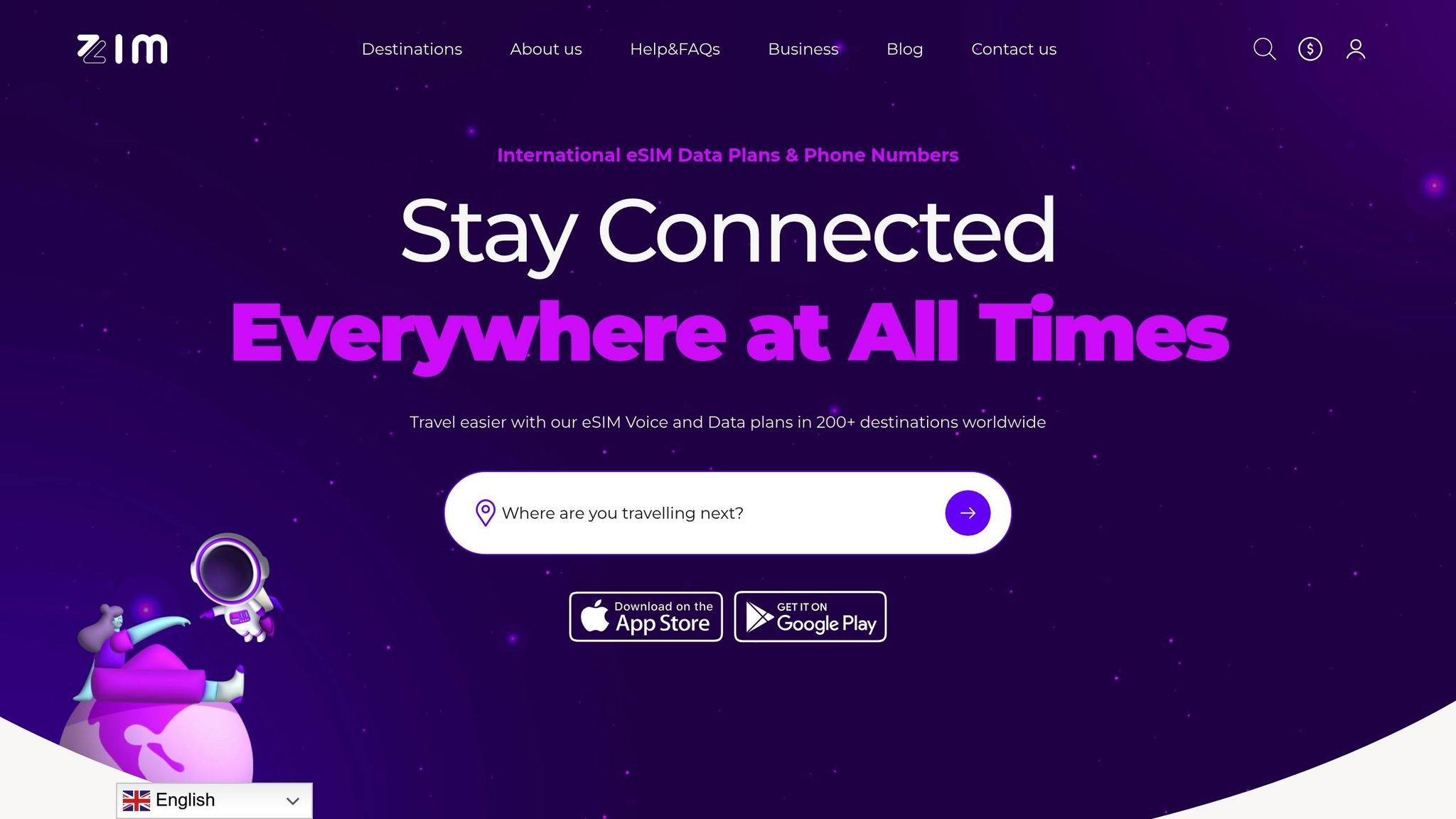How eSIMs Support Sustainable Device Use
https://www.zimconnections.com/how-esims-support-sustainable-device-use/
 SHARE
SHARE
eSIM technology replaces physical SIM cards with a digital alternative embedded directly into devices. This shift reduces waste, cuts carbon emissions, and simplifies connectivity for users. By eliminating the need for plastic cards, packaging, and shipping, eSIMs offer a more efficient solution for mobile connectivity while supporting eco-conscious practices.
Key Highlights:
- Plastic Waste Reduction: Over 4.5 billion SIM cards are produced annually, generating 18,000 tonnes of plastic waste. eSIMs eliminate this entirely.
- Lower Carbon Emissions: eSIMs generate 46% fewer CO₂ emissions over their lifecycle compared to physical SIM cards.
- Cost Savings: eSIMs cost between £0.16 and £0.40, significantly less than traditional SIM cards (£2.00).
- Improved Device Design: Removing SIM slots allows for smaller, sleeker devices and more efficient manufacturing.
- Convenience for Travellers: eSIMs enable instant activation of global data plans without physical cards, reducing waste and hassle.
eSIMs are becoming the standard for mobile connectivity, with 76% of global smartphone connections expected to rely on them by 2030. Their adoption is reshaping the mobile industry by providing a cleaner, more efficient way to stay connected.
Reducing Physical Waste and Resource Use
Removing Plastic SIM Cards
Switching to eSIM technology tackles one of the mobile industry’s biggest environmental issues: the plastic waste generated by traditional SIM cards. Each year, around 4.5 billion SIM cards are produced and distributed, leading to over 18,000 tonnes of plastic waste and 560,000 tonnes of carbon dioxide emissions.
eSIMs, which are built into devices, eliminate the need for physical SIM cards entirely. This shift could prevent up to 5.4 million kg of plastic waste annually while cutting down the energy required for manufacturing and disposal. Changing network providers is managed digitally, removing any associated physical waste. Additionally, the production of eSIMs consumes far fewer resources compared to the energy-intensive process of creating traditional SIM cards.
Beyond the cards themselves, eSIMs pave the way for reducing the waste generated by packaging and logistics. With no need for physical SIM cards, the environmental footprint of the entire supply chain is significantly reduced.
Cutting Packaging and Shipping Waste
The environmental advantages of eSIMs go beyond eliminating plastic cards – they also streamline the distribution process. Activating an eSIM digitally removes the need for packaging and shipping, which reduces carbon emissions and eases supply chain demands. Traditional SIM cards require layers of packaging, including plastic carriers, cardboard backings, and protective sleeves, while eSIMs eliminate all of this. As GI-DE highlights:
"eSIM management technology replaces physical SIM cards to save on plastics, CO₂, and logistics."
By disrupting the traditional supply chain, eSIMs reduce the need for manufacturing, packaging, and global shipping of billions of SIM cards. Connectivity can now be provisioned instantly and digitally, without the environmental impact of physical transportation.
Some companies have already taken steps to reduce waste, showcasing the environmental benefits of digital SIM solutions. For instance, an eSIM produces 46% less carbon dioxide over its lifecycle compared to a traditional SIM card. Across billions of devices, this translates into a substantial reduction in global emissions. By removing the need for cardboard, plastic, and other packaging materials, eSIMs contribute to broader efforts to cut the carbon footprint tied to the production and distribution of SIM cards.
These advancements highlight how eSIM technology not only reduces material waste but also optimises the logistics of mobile connectivity.
Better Energy Efficiency in Device Making and Use
Simpler Device Design and Energy Savings
eSIMs are changing the way devices are designed by removing the need for SIM card slots. This not only simplifies manufacturing but also helps save energy. By embedding connectivity directly into devices, manufacturers can create sleeker, more compact gadgets with less complicated internal layouts, making production more efficient.
This streamlined approach brings clear environmental benefits. Without the need for SIM card readers and plastic slots, manufacturing uses less water, energy, and raw materials. These savings are already being seen in real-world applications.
The space freed up by eliminating SIM card slots also gives manufacturers the flexibility to optimise internal designs. For example, they can include larger batteries or improve cooling systems. This flexibility results in devices that are not only easier to produce sustainably but also more efficient in their everyday use. By reducing production waste and improving energy performance, eSIMs are driving a shift towards smarter, more efficient technology.
Energy Efficiency in Daily Use
Beyond manufacturing, eSIMs also contribute to energy efficiency in daily device use. In terms of battery consumption, eSIMs perform on par with traditional physical SIM cards. Experts confirm that their power usage is comparable, thanks to low-power technologies specifically designed for efficient operation.
| Feature | eSIM | Physical SIM |
|---|---|---|
| Battery Use (Single SIM) | Similar battery use in practice | Similar battery use in practice |
| Material Usage | Less than 1% of physical SIMs | Significant (plastic and metal) |
| Energy Consumption | Up to 80% less | High |
While removing mechanical SIM card readers reduces hardware complexity, the impact on everyday battery life is minimal. However, eSIMs bring a major advantage: they support remote reprogramming, eliminating the need for physical SIM replacements when switching networks or travelling abroad. This feature extends the lifespan of devices and reduces waste.
For those worried about battery performance, the biggest factors remain the same: screen brightness (30–50% of battery use), background apps (20–30%), and connectivity features (10–20%). eSIMs integrate seamlessly into this framework without adding any extra power drain. Plus, their digital nature avoids the energy costs tied to manufacturing, shipping, and disposing of physical SIM cards, adding another layer of sustainability.
It’s worth noting that manufacturing accounts for 80% of the carbon emissions from mobile devices. By using less than 1% of the materials needed for physical SIM cards, eSIMs represent a major step towards a more energy-efficient lifecycle for devices.
eSIM vs Traditional Roaming: Which is Best for International Travelers?
sbb-itb-273ea09
Lower Carbon Emissions Across the Connectivity Lifecycle
eSIM technology is making waves in sustainability by cutting carbon emissions at every stage of its lifecycle, from production to usage.
Digital Setup and Remote Activation
One of the standout environmental benefits of eSIMs is their shift from physical to digital processes. Unlike traditional SIM cards, which rely on manufacturing plants, global shipping, and physical distribution, eSIMs are activated entirely online. This eliminates the need for billions of plastic cards to be transported across the world, slashing emissions tied to logistics.
When you activate an eSIM, everything happens remotely via your device’s internet connection. No planes, trucks, or packaging are involved, which means no emissions from transportation.
In fact, research shows that eSIMs produce 46% fewer CO₂ emissions over their lifecycle compared to physical SIM cards. A single eSIM generates just 123g of CO₂, whereas a traditional SIM card produces 229g. This dramatic reduction is largely due to the elimination of transportation and packaging.
"eSIM technology eliminates the need for plastic casings, packaging, and transport, resulting in a more eco-friendly and efficient mobile experience."
Another advantage? eSIMs allow users to switch networks digitally without needing new hardware. Whether travelling abroad or changing providers, there’s no need to purchase a new SIM card. This not only extends the lifespan of devices but also reduces the environmental impact of frequent replacements.
Comparing Carbon Footprints: eSIMs vs Traditional SIMs
The environmental impact of traditional SIM cards is significant, from material extraction to disposal. By contrast, eSIMs keep their footprint minimal by operating digitally.
The production phase highlights the starkest difference. Traditional SIM cards generate 59% of their total emissions during manufacturing, which involves energy-intensive processes to create plastic cards, metal components, and protective packaging. On the other hand, eSIMs integrate directly into device chipsets, with just 2% of their emissions coming from production.
| Lifecycle Stage | Traditional SIM | eSIM | Difference |
|---|---|---|---|
| Production | 136g CO₂ eq. | 1g CO₂ eq. | 99% reduction |
| Transportation | 31g CO₂ eq. | 0g CO₂ eq. | 100% elimination |
| Usage | 15g CO₂ eq. | 1g CO₂ eq. | 93% reduction |
| End of Life | 8g CO₂ eq. | ~1g CO₂ eq. | 88% reduction |
| Total Emissions | 229g CO₂ eq. | 123g CO₂ eq. | 46% reduction |
The most striking improvement comes from the transportation phase, where eSIMs entirely eliminate the 31g of CO₂ emissions that traditional SIM cards generate through global shipping and distribution. This means no cargo flights, shipping containers, or delivery vehicles are required to move SIM cards around the world.
Projections for eSIM adoption show even more promise. A shift by just 5% of mobile users to eSIMs could save up to 15,000 tonnes of plastic and cut CO₂ emissions by 8,000 tonnes annually. If eSIMs were adopted globally, they could prevent over 143,000 tonnes of CO₂ emissions per year by 2025, which is equivalent to planting 57 million trees.
"The results of the study show the environmental impact reduction potential of eSIM as a connectivity solution. Particularly noteworthy here is the savings potential in CO₂ emissions by reducing the necessary distribution and additional hardware of the eSIM solution compared to the SIM card." – David Sánchez, Research Associate at Fraunhofer IZM
Currently, the SIM card industry generates an estimated 180,000 tonnes of CO₂ annually by manufacturing over 4.5 billion physical SIM cards worldwide. eSIM technology has the potential to cut these emissions by up to 87%, marking a major leap towards greener connectivity solutions. This shift benefits both individual users and the broader global infrastructure.
Supporting Sustainable Travel and Global Connectivity
eSIM technology doesn’t just streamline connectivity; it also supports a more environmentally friendly way to stay connected while travelling. By cutting down on physical waste and reducing the need for traditional SIM cards, eSIMs are paving the way for a greener, more seamless travel experience.
Simple Connectivity for Global Travellers
Staying connected while travelling internationally can be tricky. Traditional options like local SIM cards or paying high roaming fees often create unnecessary waste and expense. eSIMs solve this problem by embedding connectivity directly into devices. Travellers can activate new plans instantly without needing to buy or discard physical SIM cards, significantly reducing waste.
Many providers now offer prepaid data plans that work in over 190 countries and regions. On supported iPhone models, users can store eight or more eSIMs and activate two at the same time. This feature allows travellers to keep their home number active while using a local data plan or switch between regional plans with ease. For UK travellers, this means hassle-free connectivity that’s both convenient and sustainable.
Benefits for UK Travellers
For UK travellers, eSIMs offer a winning combination of practicality and eco-consciousness. The traditional approach of buying local SIM cards or paying roaming fees is not only costly but also generates unnecessary plastic waste. With eSIMs, UK travellers can purchase prepaid plans online before their trip or activate them digitally upon arrival. This eliminates the need to search for local SIM cards at airports or shops.
The flexibility of eSIMs is especially useful for multi-destination trips, which are popular among UK travellers. Instead of juggling multiple SIM cards – each with its own packaging and activation process – you can simply switch between stored eSIMs in your device settings. With most modern smartphones now supporting eSIM technology, staying connected sustainably has never been simpler.
ZIM Connections: A Sustainable Connectivity Solution

ZIM Connections tackles the challenge of international connectivity with a digital-first approach. The platform offers instant eSIM activation via QR codes, cutting out the need for plastic SIM cards and delivery delays. Travellers can choose from plans covering over 200 destinations, with prices starting at just £1. The process is straightforward: purchase a plan, receive an activation code via email, and scan the QR code to add the eSIM to your device. This eliminates the need for physical SIM cards, reducing both waste and costs.
"To create a world where connectivity knows no boundaries … where everyone feels confident to pursue their dreams, and each moment is a chance to connect, share and create unforgettable memories."
― ZIM Connections
With smartphone eSIM adoption predicted to reach 76% by 2030 and the eSIM market estimated to grow to £27.2 billion by 2033, platforms like ZIM Connections are leading the charge in sustainable travel solutions. By offering instant, eco-friendly connectivity, ZIM Connections highlights how eSIMs are reshaping global travel for the better.
Conclusion: The Future of Energy-Efficient, Sustainable Connectivity
Key Points on eSIMs and Sustainability
eSIM technology is transforming connectivity by reducing plastic waste and cutting carbon emissions. By eliminating the need for physical SIM cards, along with their manufacturing, packaging, and shipping, eSIMs offer a more environmentally friendly alternative. Digital activation eliminates the need for in-person retail visits and air shipments, while streamlined device designs contribute to energy efficiency through remote provisioning and easier connectivity adjustments. For UK travellers and businesses, these advancements align with goals for environmental responsibility and sustainable practices, marking a shift towards digital-first connectivity across sectors.
The Role of eSIMs in a Greener Future
The adoption of eSIMs is accelerating in both public and private sectors, proving to be a practical step towards sustainability. A notable example is Defra’s 2025 integration of eSIM technology across its mobile estate, with a 15% sustainability weighting in its procurement process. Lydia Tabbron, Defra’s Digital Sustainability Lead, highlighted the significance of this initiative:
"Defra’s adoption of eSIM technology is more than just a digital upgrade – it marks a strategic milestone in our journey towards net zero and responsible procurement. This initiative sends a powerful signal to the wider supplier market: sustainability is no longer optional – it’s a core expectation." – Lydia Tabbron, Defra Digital Sustainability Lead
This momentum is mirrored by major players in the tech industry. Companies like Apple, Samsung, and Google are incorporating eSIM functionality into their devices, while network providers continue expanding support for the technology. For environmentally conscious individuals and businesses, choosing providers that prioritise digital-first solutions – such as ZIM Connections – offers a tangible way to reduce their environmental footprint. As eSIM technology advances, it promises to play a vital role in shaping a more sustainable, efficient, and interconnected future for both the UK and global markets.
FAQs
How do eSIMs help reduce the environmental impact of mobile connectivity?
eSIMs play a role in promoting a greener future by cutting down on plastic waste and CO₂ emissions. Unlike traditional SIM cards, eSIMs are built directly into devices, which means there’s no need for plastic cards, bulky packaging, or shipping. This streamlined approach not only reduces waste but also lowers the carbon footprint tied to production and transportation.
Another benefit of eSIMs is their ability to extend the lifespan of devices. Since users can switch networks or plans digitally, there’s no need to physically swap out SIM cards. This ease of use supports more sustainable practices by helping to decrease electronic waste over time.
How do eSIMs benefit international travellers and make staying connected easier?
eSIMs provide international travellers with a seamless way to stay connected, eliminating the need to carry or swap physical SIM cards. They minimise the risk of losing a SIM and allow you to activate your mobile plan instantly – even before you land at your destination.
With eSIMs, you can access affordable connectivity via local, regional, or global plans, helping you sidestep hefty roaming fees. Plus, they support dual active plans, so you can keep your home number active while using a local plan at the same time. This feature makes staying connected across multiple countries straightforward and hassle-free, adding convenience to your travel experience.
How does eSIM technology contribute to more sustainable device design and manufacturing?
eSIM technology is making strides towards a greener future by doing away with the need for physical SIM cards. This change cuts down on plastic waste and lessens the environmental toll of extracting resources. Plus, it streamlines production, paving the way for recycled materials and more eco-conscious manufacturing practices.
Another big win? eSIMs drastically lower the carbon footprint tied to logistics. Without the need to produce, package, or ship physical SIM cards, there’s a noticeable reduction in emissions. On top of that, eSIMs allow devices to be smaller and more efficient, boosting energy efficiency in modern tech and aligning with sustainable design goals.









































































































































































































